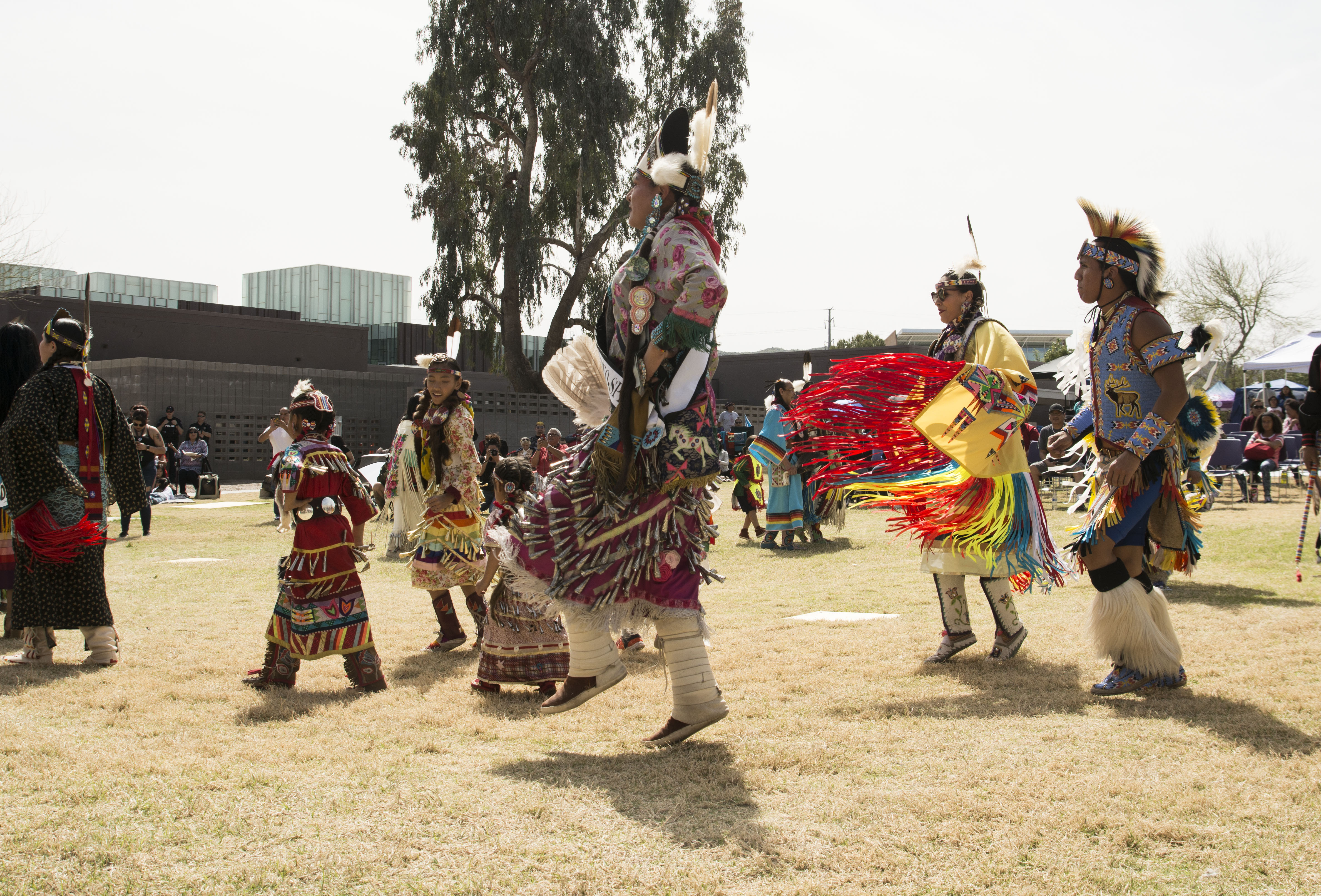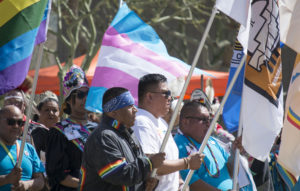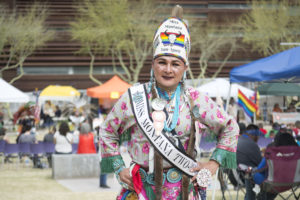The sound of drums, singing and prayers marked the opening of a powwow in Phoenix on a Saturday afternoon this month. Marchers carried the flags of the United States and some of Arizona’s tribal nations onto the grass field, but the procession also included rainbow flags, and the pink and blue transgender flag. It was Arizona’s first Two-Spirit Powwow, one of a handful of powwows that have sprung up across North America to celebrate LGBT Native Americans.
Among the marchers in the grand entry was Kay Kisto, the reigning Miss Indian Transgender Arizona. “To actually be here, to be at the first-ever [Two-Spirit Powwow] in Arizona — I’ve been having goose bumps ever since I got here,” Kisto said.
Kisto, 35, grew up on the Gila River Indian Reservation, south of Phoenix. Growing up, she feared harassment or violence if she were to reveal her transgender identity. But to be able to celebrate her identity and heritage in an event on her tribe’s traditional lands was an overwhelming feeling and a sign of change, she said.
Dozens of Two-Spirit organizations have formed around North America in recent years. California’s Bay Area American Indian Two-Spirit Powwow is now in its eighth year and draws as many as 4,000 attendees annually. Canadian cities Saskatoon and Winnipeg have recently hosted Two-Spirit powwows. And in 2018, a Two-Spirit contingent took part in the grand entry at the Gathering of Nations, the world’s largest powwow, for the first time.
Two-Spirit, an umbrella term for non-binary definitions of gender and sexuality from Native American traditions, takes inspiration from terminology in the Ojibwe language for men who filled women’s roles in society, or women who took on men’s roles. Many of North America’s indigenous traditions include more than just male and female understandings of gender, but hundreds of years of forced assimilation stamped out many tribes’ customs and oral traditions. Two-Spirit powwows are part of a growing movement among Native Americans who say rigid ideas of gender and sexuality are unfortunate remnants of colonization — participants say it’s time to rethink native identities on their own terms.
“There’s no way you can talk about colonization without talking about gender and sexuality,” said Chris Finley, assistant professor of American studies and ethnicity at the University of Southern California, and member of the Colville Nation.
When Europeans came to North America, they brought patriarchal societal traditions with them, Finley said. Wrapped up in those gender roles were Europeans’ understandings of land ownership and inheritance, ideas that were crucial to the process of seizing the continent from indigenous people.
Among the measures used to extinguish native customs in the United States was the state-sponsored Native American boarding school program, which forced generations of indigenous children to attend school away from their families to be educated in Christian, European traditions.
“If you don’t lose your language, start practicing Christianity, cut your hair, learn to speak English, you will die. That’s the choice so many native people were given,” said Roger Kuhn, board member of Bay Area American Indian Two-Spirits, and member of the Poarch Band of Creek Indians.
“Assimilation means you lose a lot of your identity,” Kuhn said, “and in that assimilation process I think is where we went astray with sexuality.”
Navajo tradition includes at least four genders. But generations of Navajo people like Sheila Lopez never learned that piece of cultural history.
Lopez grew up in Winslow, Ariz., just outside the Navajo Nation Reservation. Two of her three children identify as gay. Lopez is the founder of Phoenix Native PFLAG, the only Native American-focused chapter of the nationwide organization for families and allies of LGBT people.
“This community is marginalized and stigmatized and harassed,” Lopez said. “When [my children] came out, it was so hard for me, because I knew that society wasn’t so accepting.” Attitudes toward LGBT people vary across North America’s more than 500 distinct indigenous cultures, but a 2015 survey from the National Center for Transgender Equality found transgender Native Americans experienced disproportionately high rates of rejection by immediate family compared with transgender people from other backgrounds. Same-sex marriage remains a point of debate in some tribes.
It was only after learning her children were gay that Lopez first heard of the Navajos’ broader definitions of gender.
“For me, it’s like, why wasn’t I taught that?” she said. “We need to start talking about bringing back those traditions of accepting everyone no matter your orientation or your gender expression.”
In planning the Arizona Two-Spirit Powwow, Lopez looked to the BAAITS Powwow. Kuhn said the event includes the music, food, dancing and handicrafts common to powwows across North America, but it takes a unique approach to gender. A Native American drum circle is generally defined as a male space, while some dance styles such as the buckskin dance are typically performed by women. Early in its history, the BAAITS Powwow did away with those gender rules.
Stereotypes about Native Americans often conflate living people with ancient cultures. “We’re the only race who’s expected to stay exactly the same,” Finley said. For her, gender and sexuality present exciting opportunities to create new native traditions.
“A lot of the things that come up with gender and sexuality are things that we actually can change within our own communities,” Finley said. “We don’t have to wait for settlers to pass acts of Congress or start giving us our land back. This is work we can do now, for ourselves, with ourselves.”
Read this story on the Washington Post


